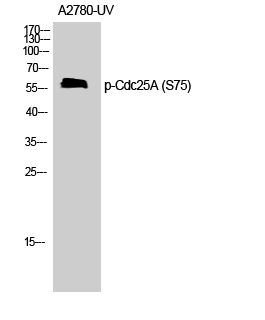Phospho CDC25A (S75) Cell-Based Colorimetric ELISA Kit
- Catalog No.:KA1550C
- Applications:ELISA
- Reactivity:Human;Mouse;Rat
- Gene Name:
- CDC25A
- Human Gene Id:
- 993
- Human Swiss Prot No:
- P30304
- Mouse Swiss Prot No:
- P48964
- Rat Swiss Prot No:
- P48965
- Storage Stability:
- 2-8°C/6 months
- Other Name:
- M-phase inducer phosphatase 1 (EC 3.1.3.48) (Dual specificity phosphatase Cdc25A)
- Detection Method:
- Colorimetric
- Background:
- catalytic activity:Protein tyrosine phosphate + H(2)O = protein tyrosine + phosphate.,domain:The phosphodegron motif mediates interaction with specific F-box proteins when phosphorylated. Putative phosphorylation sites at Ser-79 and Ser-82 appear to be essential for this interaction.,enzyme regulation:Stimulated by B-type cyclins.,function:Tyrosine protein phosphatase which functions as a dosage-dependent inducer of mitotic progression. Directly dephosphorylates CDC2 and stimulates its kinase activity. Also dephosphorylates CDK2 in complex with cyclin E, in vitro.,PTM:Phosphorylated by CHEK1 on Ser-76, Ser-124, Ser-178, Ser-279, Ser-293 and Thr-507 during checkpoint mediated cell cycle arrest. Also phosphorylated by CHEK2 on Ser-124, Ser-279, and Ser-293 during checkpoint mediated cell cycle arrest. Phosphorylation on Ser-178 and Thr-507 creates binding sites for YWHAE/14-3-3 epsilon which inhibits CDC25A. Phosphorylation on Ser-76, Ser-124, Ser-178, Ser-279 and Ser-293 may also promote ubiquitin-dependent proteolysis of CDC25A.,PTM:Ubiquitinated. Association with the F-box proteins BTRC and FBXW11 targets the protein for ubiquitination by CUL1 and proteolysis by the ubiquitin-dependent proteasome pathway.,similarity:Belongs to the MPI phosphatase family.,similarity:Contains 1 rhodanese domain.,subunit:Interacts with CCNB1/cyclin B1. Interacts with YWHAE/14-3-3 epsilon when phosphorylated. Interacts with CUL1 specifically when CUL1 is neddylated and active. Interacts with BTRC/BTRCP1 and FBXW11/BTRCP2. Interactions with CUL1, BTRC and FBXW11 are enhanced upon DNA damage.,
- Function:
- regulation of cyclin-dependent protein kinase activity, G1/S transition of mitotic cell cycle, M phase of mitotic cell cycle,mitotic cell cycle, M phase, nuclear division, DNA metabolic process, DNA replication, protein amino acid dephosphorylation, phosphorus metabolic process, phosphate metabolic process, cell cycle, mitosis, cell proliferation,dephosphorylation, regulation of phosphate metabolic process, cell cycle process, cell cycle phase, regulation of phosphorylation, regulation of kinase activity, regulation of protein kinase activity, organelle fission, regulation of phosphorus metabolic process, cell division, interphase, interphase of mitotic cell cycle, regulation of transferase activity, regulation of cell cycle,
- June 19-2018
- WESTERN IMMUNOBLOTTING PROTOCOL
- June 19-2018
- IMMUNOHISTOCHEMISTRY-PARAFFIN PROTOCOL
- June 19-2018
- IMMUNOFLUORESCENCE PROTOCOL
- September 08-2020
- FLOW-CYTOMEYRT-PROTOCOL
- May 20-2022
- Cell-Based ELISA│解您多样本WB检测之困扰
- July 13-2018
- CELL-BASED-ELISA-PROTOCOL-FOR-ACETYL-PROTEIN
- July 13-2018
- CELL-BASED-ELISA-PROTOCOL-FOR-PHOSPHO-PROTEIN
- July 13-2018
- Antibody-FAQs


